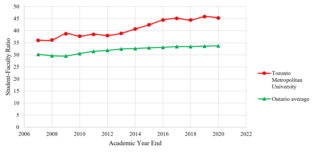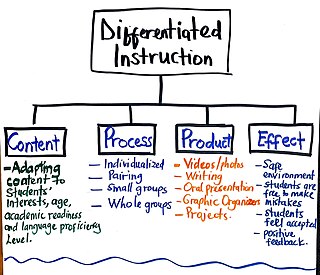
A teacher, also called a schoolteacher or formally an educator, is a person who helps students to acquire knowledge, competence, or virtue, via the practice of teaching.
Special education is the practice of educating students in a way that accommodates their individual differences, disabilities, and special needs. This involves the individually planned and systematically monitored arrangement of teaching procedures, adapted equipment and materials, and accessible settings. These interventions are designed to help individuals with special needs achieve a higher level of personal self-sufficiency and success in school and in their community, which may not be available if the student were only given access to a typical classroom education.
Educational assessment or educational evaluation is the systematic process of documenting and using empirical data on the knowledge, skill, attitudes, aptitude and beliefs to refine programs and improve student learning. Assessment data can be obtained by examining student work directly to assess the achievement of learning outcomes or it is based on data from which one can make inferences about learning. Assessment is often used interchangeably with test but is not limited to tests. Assessment can focus on the individual learner, the learning community, a course, an academic program, the institution, or the educational system as a whole. The word "assessment" came into use in an educational context after the Second World War.
Minimally invasive education (MIE) is a form of learning in which children operate in unsupervised environments. The methodology arose from an experiment done by Sugata Mitra while at NIIT in 1999, often called The Hole in the Wall, which has since gone on to become a significant project with the formation of Hole in the Wall Education Limited (HiWEL), a cooperative effort between NIIT and the International Finance Corporation, employed in some 300 'learning stations', covering some 300,000 children in India and several African countries.
A Sudbury school is a type of school, usually for the K-12 age range, where students have complete responsibility for their own education, and the school is run by a direct democracy in which students and staff are equal citizens. Students use their time however they wish, and learn as a by-product of ordinary experience rather than through coursework. There is no predetermined educational syllabus, prescriptive curriculum or standardized instruction. This is a form of democratic education. Daniel Greenberg, one of the founders of the original Sudbury Model school, writes that the two things that distinguish a Sudbury Model school are that everyone is treated equally and that there is no authority other than that granted by the consent of the governed.
Cooperative learning is an educational approach which aims to organize classroom activities into academic and social learning experiences. There is much more to cooperative learning than merely arranging students into groups, and it has been described as "structuring positive interdependence." Students must work in groups to complete tasks collectively toward academic goals. Unlike individual learning, which can be competitive in nature, students learning cooperatively can capitalize on one another's resources and skills. Furthermore, the teacher's role changes from giving information to facilitating students' learning. Everyone succeeds when the group succeeds. Ross and Smyth (1995) describe successful cooperative learning tasks as intellectually demanding, creative, open-ended, and involve higher-order thinking tasks. Cooperative learning has also been linked to increased levels of student satisfaction.
The Education Quality and Accountability Office (EQAO) is a Crown agency of the Government of Ontario in Canada. It was legislated into creation in 1996 in response to recommendations made by the Royal Commission on Learning in February 1995.

Learner autonomy has been a popular concept in foreign language education in the past decades, specially in relation to lifelong learning skills. It has transformed old practices in the language classroom and has given origin to self access language learning centers around the world such as the SALC at Kanda University of International Studies in Japan, the ASLLC at The Education University of Hong Kong, the SAC at Hong Kong University of Science and Technology and ELSAC at the University of Auckland. As the result of such practices, language teaching is now sometimes seen as the same as language learning, and it has placed the learner in the centre of attention in language learning education in some places.

Education in El Salvador is regulated by the country's Ministry of Education. El Salvador consists of the following levels of education:
An open classroom is a student-centered learning space design format which first became popular in North America in the late 1960s and 1970s, with a re-emergence in the early 21st century.

The student-teacher ratio, or student-faculty ratio, is the number of students who attend a school or university divided by the number of teachers in the institution. For example, a student-teacher ratio of 10:1 indicates that there are 10 students for every teacher. The term can also be reversed to create a teacher-student ratio.
English-language learner is a term used in some English-speaking countries such as the United States and Canada to describe a person who is learning the English language and has a native language that is not English. Some educational advocates, especially in the United States, classify these students as non-native English speakers or emergent bilinguals. Various other terms are also used to refer to students who are not proficient in English, such as English as a second language (ESL), English as an additional language (EAL), limited English proficient (LEP), culturally and linguistically diverse (CLD), non-native English speaker, bilingual students, heritage language, emergent bilingual, and language-minority students. The legal term that is used in federal legislation is 'limited English proficient'.

Formative assessment, formative evaluation, formative feedback, or assessment for learning, including diagnostic testing, is a range of formal and informal assessment procedures conducted by teachers during the learning process in order to modify teaching and learning activities to improve student attainment. The goal of a formative assessment is to monitor student learning to provide ongoing feedback that can help students identify their strengths and weaknesses and target areas that need work. It also helps faculty recognize where students are struggling and address problems immediately. It typically involves qualitative feedback for both student and teacher that focuses on the details of content and performance. It is commonly contrasted with summative assessment, which seeks to monitor educational outcomes, often for purposes of external accountability.
Grade skipping is a form of academic acceleration, often used for academically talented students, that enables the student to skip entirely the curriculum of one or more years of school. Grade skipping allows students to learn at an appropriate level for their cognitive abilities, and is normally seen in schools that group students primarily according to their chronological age, rather than by their individual developmental levels. Grade skipping is usually done when a student is sufficiently advanced in all school subjects, so that they can move forward in all subjects or graduate, rather than in only one or two areas. There are alternatives to grade skipping.
The jigsaw technique is a method of organizing classroom activity that makes students dependent on each other to succeed. It breaks classes into groups that each assemble a piece of an assignment and synthesize their work when finished. It was designed by social psychologist Elliot Aronson to help weaken racial cliques in forcibly integrated schools. A study by John Hattie found that the jigsaw method benefits students' learning.
Age segregation in schools, age grading, or graded education is the separation of students into years of education by approximately the same age. It is based on the theory that learners of the same age at the same level of social and intellectual maturity should be taught at the same pace. Here, schools classify learners according to age cohorts with the expectation that those with similar age share needs, abilities, and interests. It also forms part of the standardized learning organized in stages and progresses in predictable and known ways.

Differentiated instruction and assessment, also known as differentiated learning or, in education, simply, differentiation, is a framework or philosophy for effective teaching that involves providing all students within their diverse classroom community of learners a range of different avenues for understanding new information in terms of: acquiring content; processing, constructing, or making sense of ideas; and developing teaching materials and assessment measures so that all students within a classroom can learn effectively, regardless of differences in their ability. Differentiated instruction means using different tools, content, and due process in order to successfully reach all individuals. Differentiated instruction, according to Carol Ann Tomlinson, is the process of "ensuring that what a student learns, how he or she learns it, and how the student demonstrates what he or she has learned is a match for that student's readiness level, interests, and preferred mode of learning." According to Boelens et al. (2018), differentiation can be on two different levels: the administration level and the classroom level. The administration level takes the socioeconomic status and gender of students into consideration. At the classroom level, differentiation revolves around content, processing, product, and effects. On the content level, teachers adapt what they are teaching to meet the needs of students. This can mean making content more challenging or simplified for students based on their levels. The process of learning can be differentiated as well. Teachers may choose to teach individually at a time, assign problems to small groups, partners or the whole group depending on the needs of the students. By differentiating product, teachers decide how students will present what they have learned. This may take the form of videos, graphic organizers, photo presentations, writing, and oral presentations. All these take place in a safe classroom environment where students feel respected and valued—effects.
Multi-age classrooms or composite classes are classrooms with students from more than one grade level. They are created because of a pedagogical choice of a school or school district. They are different from split classes which are formed when there are too many students for one class – but not enough to form two classes of the same grade level. Composite classes are more common in smaller schools; an extreme form is the one-room school.
The gradual release of responsibility (GRR) model is a structured method of pedagogy centred on devolving responsibility within the learning process from the teacher to the learner. This approach requires the teacher to initially take on all the responsibility for a task, transitioning in stages to the students assuming full independence in carrying it out. The goal is to cultivate confident learners and thinkers who are capable of handling tasks even in areas where they have not yet gained expertise.

In the United States, elementary schools are the main point of delivery of primary education, for children between the ages of 4–11 and coming between pre-kindergarten and secondary education.






